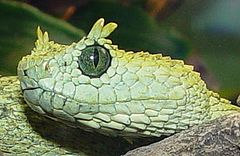- Ocular scales
-
- "Circumorbital" redirects here. This may also refer to the area surrounding the eye sockets in other animals.
In scaled reptiles, the ocular scales are those forming the margin of the eye.[1] The name originates from the term oculus which is Latin for "eye" and, in the broadest sense, refers to a scale associated with the eye. The numbers of these scales present, and sometimes the shapes and sizes, are some of many characteristics used to differentiate species from one another.
Prefixes are usually included to indicate the positions or locations of the individual scales:[2][3]
- Preocular scales, or preoculars, are those lying directly in front of and in contact with the eye.
- Postocular scales, or postoculars, are those lying directly behind and in contact with the eye.
- Supraocular scales, or supraoculars, are enlarged scales on the crown immediately above the eye.
- Subocular scales, or suboculars, are those lying directly below and in contact with the eye.
Collectively these scales are referred to as circumorbital scales, circumorbitals, or a circumorbital ring.
Occasionally, the term ocular scale is used without a prefix, in which case it specifically refers to the brille, also known as the spectacle[4] or eyecap.[5] This is a transparent scale that covers and protects the eye. It is formed in embryonic snakes when the transparent upper and lower eyelids fuse together. Once hatched, a snake does not possess eyelids and the brille carries out some of these functions.[5]
See also
References
- ^ Wright AH, Wright AA. 1957. Handbook of Snakes. Comstock Publishing Associates (7th printing, 1985). 1105 pp. ISBN 0-8014-0463-0.
- ^ Mallow D, Ludwig D, Nilson G. 2003. True Vipers: Natural History and Toxinology of Old World Vipers. Malabar, Florida: Krieger Publishing Company. 359 pp. ISBN 0-89464-877-2.
- ^ Smith MA. 1943. The Fauna of British India, Ceylon and Burma including the whole of the Indo-Chinese Sub-region, Reptilia and Amphibia Vol III-Serpentes. Taylor and Francis, London. page 29.
- ^ Are snakes slimy? at Singapore Zoological Garden's Docent. Accessed 14 August 2006.
- ^ a b Evolution of snakes. Accessed 21 August 2006.
Categories:
Wikimedia Foundation. 2010.


